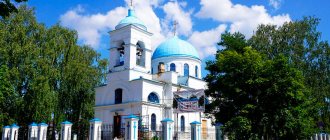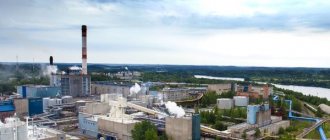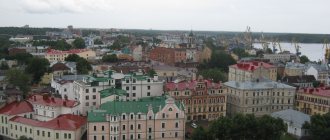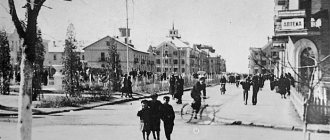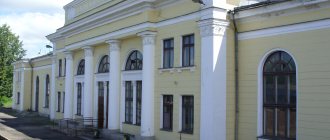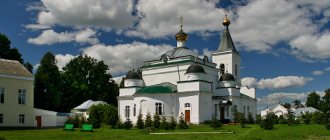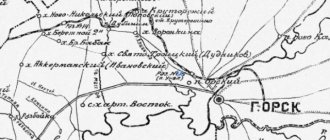Kirovsk is one of the cities in the Leningrad region of Russia. Established in 1931 as a workers' settlement at the State District Power Plant. Since 1953 it has the status of a city. It is a typical Soviet settlement. The name was given after the political and statesman, revolutionary S. M. Kirov, who lived from 1886 to 1934. The sights of the city of Kirovsk are quite unusual and few in number.
About the history of the city
The city was founded on June 13, 1931, as a working village for the builders of a large state district power station (since 1934 it was called the Kirov State District Power Plant, and now it has become the Dubrovskaya Thermal Power Plant or State District Power Plant No. 8). The power plant was built in 3 years - 1.5-2 times faster than similar facilities were built in world practice. In March 1933, the state district power station was launched, and S.M. was present at the ceremony. Kirov.
Before receiving city status, with the renaming to Kirovsk, the working settlement was called Nevdubrstroy (Nevdubstroy) - after the nearest village Nevskaya Dubrovka. The name of Sergei Mironovich was given to the new city because it was Kirov who led Leningrad and the region in the early 1930s, and he initiated the construction of a very large power plant and the village attached to it at that time.
In the 2010s, some public organizations proposed renaming the city to Predtechensk, since it has an Orthodox church of St. John the Baptist. But the reaction of society itself to these proposals was very sluggish, so the renaming did not happen.
The state district power station and the village attached to it were captured by Nazi troops on September 7, 1941. In 1944, after the expulsion of the occupiers, the power plant had to be rebuilt: it was badly damaged during the war years. Despite all the difficulties, in March 1946, the State District Power Plant provided electricity to the reviving Leningrad.
In addition to the power plant, there are many industrial facilities operating in the city of Kirovsk. In particular, local plants and factories produce products for shipbuilding, dry construction mixtures, silicate building materials, corrugated cardboard, plastic products, high-octane fuel, and sound warning devices.
Vintage photo of the city
On the outskirts of the city there is a magnificent museum-reserve “Breakthrough the Siege of Leningrad”, which is the main attraction of Kirovsk. This museum was created directly in the places of fierce battles for Leningrad during the Great Patriotic War. This museum-reserve, the main part of which is located at the left bank abutment of the Ladoga Bridge, includes a large three-dimensional diorama dedicated to breaking the siege of Leningrad and operating since 1985, a tank-monument and an open-air museum of military equipment - a collection of tanks recovered from Ladoga and swamps in the early 2000s and restored especially for the exhibition. In 2021, a new panorama museum was opened in a new building. The museum-reserve also includes: the Nevsky Piglet memorial, Sinyavinsky Heights, the historical site of the blockade breakout (where on January 18, 1943, soldiers of the Leningrad and Volkhov fronts, advancing towards each other, met).
Population of the city of Kirovsk
The population in the city of Kirovsk has been practically stable since 1989. Before that, it was growing rapidly. In 1989, the number of residents was 23.5 thousand people, and in 2021 - 26.4 thousand. This puts the city in 564th place among other Russian cities.
The predominant nationality is Russian. Their share is 91.5%. Next come Ukrainians – 2.3%. In third place are Belarusians (1.3%). There are approximately half as many Tatars (0.6%). Representatives of other nationalities are less than 0.5 percent each.
Museum-reserve "Breakthrough the Siege of Leningrad" with a three-dimensional diorama
During the May holidays, traffic is always very busy on the road leading from the Murmansk Highway under the Ladoga Bridge. Cars and excursion buses travel in columns to the “Breaking the Siege of Leningrad” museum-reserve.
Its history began with the creation of the diorama museum “Breakthrough the Siege of Leningrad,” opened on the ramp of the Ladoga Bridge on May 9, 1985, when the USSR celebrated the 40th anniversary of the Great Victory. Here, near the village of Maryino, Kirov district, Leningrad region, the legendary operation to break the blockade of Leningrad took place, codenamed “Iskra”.
Reproduce it on an artistic and documentary canvas; It was planned to immortalize the events of the winter of 1943 in the very place where the blockade of the Northern capital was broken even before the end of the Great Patriotic War, but this idea was realized only in the early 1980s.
A group of artists spent 3 years creating a huge painting with an area of 320 square meters. As consultants, they involved direct participants in those dramatic events - war veterans who contributed to the success of Operation Iskra - to work on the panorama.
For example, in the original version of the diorama on the banks of the Neva, they depicted a command observation post, where full-length figures of Soviet senior officers were drawn. Veterans criticized the idea of placing military command in close proximity to the front line. Therefore, the painters had to draw a firing point in this place instead of a control post.
Museum-reserve "Breakthrough the Siege of Leningrad" with a three-dimensional diorama
The canvas, measuring 40 by 8 meters, located in a ribbon-shaped semicircle, reveals in great detail the events of Operation Iskra. Right before the eyes of museum visitors, thousands of Soviet soldiers go on the attack, with the support of military equipment and aircraft. The terrain is reproduced in such detail that the diorama literally smells of the frosty winter of 1943.
The volumetric part of the diorama depicts the entire bank of the Neva River, riddled with craters, firing points, and trenches. The craftsmen managed to make the line between the model and the canvas completely invisible. It is very difficult to track where the three-dimensional layout part ends and the pictorial part begins.
Memorial stones were solemnly lined up in front of the museum. There are 7 of them - according to the number of days of Operation Iskra. Each of them contains a memorable date and a short summary of events.
The most popular part of the museum among visitors with children is the open-air exhibition in which Soviet tanks that participated in the battles for Leningrad were collected. The first exhibit, the heavy Soviet tank KV-1, was lifted from the Neva in 2003.
In 2007, another KV-1 tank, painted in “winter camouflage” - white paint, was raised from a 15-meter depth of Lake Ladoga. Its release date was September 1941, and already on November 30 the KV was shot down at the Nevsky Piglet. Other armored vehicles are also real, pulled out of the water and swamps, and then carefully restored.
In 2021, modern tanks appeared on the territory of the museum complex “Breakthrough the Siege of Leningrad” - a gift to the museum from the Russian Ministry of Defense. The exhibition of modern technology was called “Heirs of Heroes”.
And on January 18, 2021, a new three-dimensional panorama “Breakthrough” was opened in a separate building on the territory of the museum complex, made in the modern format of the museum space, providing “full immersion” in the described events of the Great Patriotic War. Both documentary footage and animated films are used, telling about the life of the besieged city and the troops that defended it.
An expanded panorama recreates battle scenes. In it, the creators used thirty figures - depicting real people who fought at this point. A story is told about each of them, facts of his biography are given.
Also interesting is the rich collection of weapons, equipment, ammunition, equipment, and personal belongings discovered by search teams in the Leningrad region.
Population and administrative structure
The population of the Kirov region is 105.7 thousand people. Density is about 41 people per square kilometer. The population is growing, facilitated by proximity to St. Petersburg and, as a result, migration from other regions or districts of the Leningrad region. The national composition is dominated by Russians with a share of 92%.
It consists of 3 rural and eight urban settlements, which include one hundred settlements. Rural settlements: Putilovskoye, Sukhoye and Shumskoye with a total population of 6,700 people.
Table. Urban settlements of the Kirov region.
| Name | Center | Population | Settlements included |
| Otradnenskoye | Otradnoye city | 25400 | 1 |
| Sinyavinskoe | Urban-type settlement Sinyavino | 4300 | 1 |
| Shlisselburgskoe | Shlisselburg city | 14700 | 1 |
| Kirovskoe | City of Kirovsk | 27500 | 2 |
| Mginskoye | Urban settlement Mga | 12400 | 19 |
| Nazievskoe | Urban settlement Nazia | 5050 | 15 |
| Pavlovskoe | Urban settlement Pavlovo | 3660 | 4 |
| Priladozhskoe | Urban settlement Priladozhsky | 6000 | 2 |
Monument to the fallen Baltic soldiers
The monument was erected next to a mass grave in which 4,530 Soviet soldiers were buried, of which 2,616 were known, 1,914 were unknown. According to the Kirov RVC, there are 4720 of them...
Monument to the fallen Baltic soldiers
Among them are Heroes of the Soviet Union, machine gunner Ivan Fedorovich Shushin (1924-1943) and I-16 fighter pilot Anatoly Ivanovich Kuznetsov (1914-1943). The names of 1,070 people who gave their lives here for their Motherland are immortalized on memorial plaques.
Location: st. Krasnoflotskaya.
Economics and transport
The economy of the Kirov region is diverse; enterprises operate here in different industries and business areas. Agriculture is developed, various equipment is produced, and there is a shipbuilding plant. The food industry is developed, where the most famous. The Sinyavinskaya poultry farm, which is the largest producer of chicken eggs in the Northwestern Federal District, also operates here.
From an economic point of view, the Kirovsky district is one of the most developed in the Leningrad region. A big plus is the diversity of the economy; there is no pronounced emphasis on certain sectors.
The R-21 “Kola” highway passes through the Kirovsky district. There are also two railway lines, which merge into one near Mga and go to St. Petersburg.
Mass grave of Red Army soldiers on Sovetskaya Street
This monument marks the place where 6,250 people were buried in a mass grave, of which 3,971 were known, 2,279 were unknown. According to the Kirov RVC, there are 5,742 fallen heroes here. The names of 1,083 soldiers and officers are marked on the memorial plaques.
Mass grave of Red Army soldiers on Sovetskaya Street
City of Kirovsk: TOP-5 things to see in 1 day
The best place to start exploring the city is from the central square, the largest museum center and the unique polar garden. In addition to these three attractions, it is worth seeing the famous “Snow Village” and the symbol of the city - a monument to the politician S. Kirov.
Museum and Exhibition Center
- Address: ave. Lenina, 4A.
The largest Kirov Museum belongs to the group and is dedicated to mining. Eight halls housed a huge collection of minerals and ore, as well as realistic mine models with lighting and an alarm siren. On the second floor of the building you can see a large collection of antique samovars and coffee grinders. The exhibition hall hosts temporary art exhibitions.
The center is equipped with the most modern equipment, it has multimedia exhibitions, special devices for people with disabilities and audio guides in three languages: Russian, English and Finnish. A beautiful building in European style was built for the exposition. On the right side, a tower with a mechanical clock is attached to the center, which gives it a resemblance to London's Big Ben.
Polar Alpine Garden
- Coordinates on the map: 67.652054, 33.666649.
The country's northernmost botanical garden was founded in 1931. An area of more than 1,200 hectares covers the valley of the Vudyavryok River and one of the slopes of Mount Vudyavchorr.
PABSI is a kind of nature reserve; the main goal of specialists from the very beginning was to preserve the unique flora of the Arctic, which was greatly damaged by human activity, in particular from the mining of apatite. Over time, the botanical collection began to be replenished with more exotic plants, atypical for the North: palm trees, cacti, trees and flowers from central Russia.
A distinctive feature of the garden is the adaptation of plants to harsh climates: almost all species, even the whimsical tropical ones, grow not in greenhouse conditions, but in open ground. The most fastidious ones are placed in spacious greenhouses. PABSI also has a place for fauna: the small zoo is home to polar mice, hares and moose.
Snow village
- Address: Botanical Station quarter.
One of the city's most spectacular sights can only be seen once a year. “Snow Village” is an entire architectural complex built from snow and ice at the foot of Mount Vudyavchorr. The cold village has houses, a cinema, a cafe and a whole park of sculptures and winter attractions.
At night, colorful lights are lit in each building, which makes the delightful works even more beautiful. The project was created in 2021 and has since become an annual tradition. Both local residents and guests of the town are looking forward to this joyful event. For those interested, master classes on making ice statues are held.
central square
- Address: Lenin Avenue.
The main square of the city is located next to the former ANOF-1 enterprise and has the shape of a crescent. The square resembles a large square planted with trees, in the very center there is a round flowerbed, and at the edge there is a beautiful fountain with a picture of deer.
Within walking distance of this place are many city attractions, old buildings and the Severnaya Hotel, built in 1953, which received the nickname “crooked” for its semicircular shape.
Monument to S.M. Kirov
- Address: Lenin Avenue.
Kirovsk bears the name of the famous revolutionary Sergei Kirov, who led the development of the Kola Peninsula and visited the city twice as first secretary of the All-Russian Communist Party of the Soviet Union. For the first five years of its existence, the working settlement near Mount Kukisvumchorr was called Khibinogorsk.
At the beginning of December 1934, Sergei Mironovich was killed, and two weeks later the Central Executive Committee of the USSR renamed the northern town in memory of the deceased communist.
Two weeks later, a monument to the politician was laid. The monument was completed in 1938. Kirov is depicted in full height, dressed in military uniform. Sergei Mironovich extends his right hand forward, it seems as if he is making a fiery speech. The bronze statue stands on a huge black pedestal on Lenin Street.
Mass grave in the village of Maryino
A beautiful sculptural group marks the mass grave of Soviet soldiers in the village of Maryino. In it lies the Hero of the Soviet Union Dmitry Semyonovich Molodtsov, who on January 13, 1943 repeated the selfless feat of Alexander Matrosov: he covered the enemy’s firing point with his body.
Mass grave in the village of Maryino
The monument to the fallen Red Army soldiers is made in the form of figures of a Soviet army soldier and a girl laying flowers at the memorial. The inscription on the memorial plaque reads: “To the soldiers of the Soviet army and Baltic sailors who died in battle during the breaking of the siege of Leningrad in January 1943.” 625 people are immortalized on memorial plaques here. In total, 3,135 people were buried in the mass grave, of which 1,988 were known and 1,147 were unknown. According to the Kirov district military registration and enlistment office, 3,346 people are buried in the mass grave.
Where to stay in Kirovsk 2021
Hotel Severnaya ***
Address: Lenin Ave., 11
The best hotel in the center of Kirovsk. The building has been renovated, the rooms have been freshly renovated and have new furniture (+ high-quality mattresses, bathrobes/slippers, Wi-Fi). There is a gym, spa center with swimming pool, sauna and hammam. There is a restaurant, parking, daily shuttle to the ski lifts. The buffet is great!
From 4,086 rub. on Booking.com
Sanatorium "Tirvas"
Address: Botanical Garden, 29
A hotel with a wellness and spa center, swimming pools, saunas, various recreation areas, a bar and a restaurant. 15 minutes from the slopes on Mount Kukisvumchorr. Within walking distance from the Snow Village, the Polar-Alpine Botanical Garden and the Lastochka equestrian club. The rooms are large and modern.
From 6,000 rub. on Booking.com
Hotel Gornitsa
Address: st. Dzerzhinsky, 19
Budget, but decent in many respects hotel in Kirovsk. The rooms are simple but warm and have everything you need. Including tea/coffee makers, flat screen TVs, Wi-Fi. The area offers mountain views; there is parking. Breakfast is delicious, served in the cafe.
From 2,500 rub. on Booking.com
Kirovsk is a pleasant city where it makes sense to go even for a day from Murmansk or Teriberka. And let its feature not be in architecture and sights, but in nature. In Kirovsk there is still something to see and where to spend time. It’s not easy for him to compete with Rosa Khutor and Dombay. But on the other hand, the flight from Moscow is shorter than to Sochi - only 2 hours 15 minutes.
Monument to S.M. Kirov on Teatralnaya Square
The image of the very popular party and statesman S. M. Kirov (1886-1934), who died in the prime of life under very dark circumstances, was immortalized in numerous monuments and works of art.
Monument to S.M. Kirov on Teatralnaya Square
There is such a monument in Kirovsk, Leningrad region. It was inaugurated in 1952 in front of the regional Palace of Culture. The creators of this monument were the sculptor Nikolai Vasilyevich Tomsky and the architect Evgeniy Adolfovich Levinson.
Location: st. Soviet.
Geography, relief and climate
The area of the Kirovsky district is 2590 square kilometers. It borders with St. Petersburg, as well as with the Volkhov, Tosnensky, Vsevolozhsky and Kirishi districts of the Leningrad region. In the north it is washed by Lake Ladoga, the length of the coast is 65 kilometers.
The Kirov region has dimensions of 70 by 50 kilometers (excluding the water area of Lake Ladoga). The terrain is mostly flat, although there are minor elevations in places. There are no large lakes; the Neva River flows along the western border of the region. Also worth noting is the Mga River; there are no other large rivers. There are swamps, especially in the southern and southeastern parts.
The climate is temperate continental, the average indicators of the Kirov region correspond to the Leningrad region. The average annual precipitation is 700 millimeters.
Monument to V.I. Lenin
Kirovsky Ilyich is famous for being the last of the Lenin monuments erected in the Soviet Union. This monument to the Bolshevik leader was unveiled on November 5, 1987, on the 70th anniversary of the Great October Socialist Revolution. Perestroika was already gaining momentum in the country, throwing off all previous ideals from its heights.
The history of the Kirov monument to Lenin is very interesting and even funny. It was created under time pressure: the first sculptor who took the order to make the statue had a so-called “creative crisis.”
I had to transfer the responsible matter to a new master - Vladimir Emilievich Gorevoy. He had difficulty meeting the deadline, but completed the task brilliantly. His performance of Ilyich turned out to be lively and energetic.
A funny thing happened at the opening of the monument, on the holiday of November 7, 1987. Not only did the government officials who opened it have a stray dog under their feet; the canvas made of parachute silk did not want to slide off the statue, tightly clinging to his hand. Therefore, the opening took place amid the sound of tearing fabric and restrained laughter from the crowd.
Monument to V.I. Lenin
Soon, the city and regional party committees, and then the CPSU Central Committee, began to receive angry letters from one 80-year-old Bolshevik. He pointed out that Ilyich, depicted in the monument, threw his left hand forward and upward in an appeal. From the point of view of the old communist, Lenin always gestured with his right hand, not his left, at a rally.
The second complaint of the party veteran was that Lenin points towards the Northern capital. It’s ambiguous: is the leader calling on the masses for a new revolution?
These claims were “released on the brakes.” But the old Bolshevik still achieved one of his demands: he drew the attention of the authorities to the fact that Vladimir Ilyich was pointing his hand not only in the direction of Leningrad, but also at the beer stall near the bus station building. There was nothing left to cover here, so this pub, popular among Kirov men, was liquidated.
Over the decades of its existence, the beautiful and original monument to Lenin has become an integral part of the city of Kirovsk. This is a striking monument to a bygone era. Thank God, having gone through the “dashing” 90s, we have firmly learned: we need to create, not destroy.
Location: Central square.
Features of the city
Built mostly during the Soviet period, the city of Kirovsk has largely preserved the features of that time. The views of the city may remind you of scenes from Soviet films. Many buildings, including small ones, have been preserved from those times. These are also unique attractions of Kirovsk (Len. Region). But there are also modern high-rise buildings. As expected for Soviet-style cities, there are a lot of trees all around. This, of course, makes Kirovsk more cozy and pleasant to visit. True, in the area of high-rise buildings everything is not so nice. There are also modern cottages of wealthy citizens.
Art objects “Wish Tree” and “Kiryusha the Elk Calf”
The central square of Kirovsk was also decorated with the “Wish Tree” and “Kiryusha the Elk Calf” art objects, which have become symbols of the city. The first sculpture is a fabulous Pushkin oak from Lukomorye, on which the Scientist Cat walks along a chain with a book of magical stories. According to a tradition that has spontaneously developed in many cities (not only in Kirovsk), some newlyweds hang locks on the metal branches of a fairytale oak tree and on chain links - as a symbol of the strength of their love and marriage.
“Kiryusha the Elk Cub” is the natural talisman of the Kirov region. Like the “Tree of Wishes,” this sculpture was installed on the initiative of the city authorities in 2008.
Location: Central square.
Economy of the city
Those who go on vacation to Kirovsk should keep in mind that this is primarily an industrial city, which will be interesting to visit from an educational point of view, but it may not be suitable for a good rest. There is an enterprise for the production of silicate-based building materials and a peat processing plant here. There is a large poultry farm. Barley, rye, oats, potatoes, and fodder are grown in the surrounding area. They are engaged in cattle breeding.
Deposits of limestone, sand, and peat are being developed. A new industrial zone is being created in the eastern part of the city.
Monument to Tsar Peter the Great
When there was no trace of the city of Kirovsk, before the revolution, in these places, a monument to the first Russian emperor appeared. It was installed in 1847 in the Krasnye Sosny tract, at the expense of benefactors - the Putilov stonemasons, the Spiridonov brothers.
In 2013, it was decided to recreate this monument using old photographs and drawings. The initiator of the construction of a new city landmark was St. Petersburg entrepreneur and public figure Grachya Pogosyan. He decided to finance the reconstruction of the historical monument in Krasnye Pines as a sign of gratitude for the attention and favor of Peter the Great to the Armenian people.
Monument to Tsar Peter the Great
The monument to Peter I in the city of Kirovsk was opened on June 9, 2013. The solemn event was timed to coincide with the 340th anniversary of the great Russian emperor. The monument is located in the old city park opposite the House of Culture.
Why here? It was in these places that Peter the Great stayed in the spring of 1703 on the eve of the capture of the Swedish fortress of Nyenschanz. On the marble plaque is carved in gold letters: “To Peter the Great, Father of the Fatherland. In unforgettable gratitude, the Spiridonov brothers built it with their diligence.”
In principle, we can say that the city of Kirovsk began its history with this monument. The monument in Krasnye Sosny was destroyed during the Great Patriotic War.
“I want that with the restoration of this monument, the power of the emperor will be transferred to Kirovsk and its people, so that the city will prosper and I will be remembered here with a kind word,” Grachya Poghosyan said at the opening of his brainchild.
Suddenly in the Kirov region. Shornikov's new government
It has been decided who will lead the Kirov team. For the first time, a person was sent here from the center. This is the one who was baptized “Vsevolozhsk”.
On Friday, November 19, the song of the Kirov region ended - a new leader appeared here. At 2 p.m., the Council of Deputies of the Kirov District of the Leningrad Region appointed Andrei Shornikov . His prospects for going through the competitive procedures and removing the temporary prefix are obviously high.
We told how at the end of October he suddenly kicked and... O. Yuri Faust. On the day when he was supposed to be given permanent powers, he abruptly renounced his Kirov brothers. The local elite is sure that the lady turned her head. As a result of the hormonal surge, the area was left devastated.
Whether this is true or not, at Suvorovsky, 67, they didn’t understand, they grabbed the essence. Everyone knows that Kirovsky is one of the few territories that does not favor Governor Alexander Drozdenko. It has its own historical leader - Senator Dmitry Vasilenko, who, however, seems to be pretty tired of this whole melody. So everything came together according to the classics: since the municipalities could not hold the fortress, the center, seeing a gap in the defense, made its way inside and hung up its pennant.
Finding a decent candidate for this role was also not so easy. According to 47news, the place was offered to the Chairman of the Committee on Natural Resources, Pavel Nemchinov , and the Director of the MFC of the Leningrad Region, Sergei Esipov . With Nemchinov’s career in general, everything is clearly not so simple, since the governor has recently periodically begun inviting him to go somewhere far away. I mean, from the forest he oversees. When he refused Kirovsky, they pointed to Volosovsky, which even hurt the official’s pride. Former prosecutor Esipov was more attractive to the Kirov vertical, but in the end it didn’t work out either.
Andrei Shornikov is 41 years old, and he recently celebrated one of the main events of his political biography - he became the full-fledged head of the administration of the village named after Sverdlov. 47news has repeatedly said that he fought for power in the settlement for two years, and under him, for the first time in history, A Just Russia was expelled from the council of deputies. In this case, this brand should mean not so much a party as a built-up coordinate system, in which there is even a mafia shadow.
Of course, if we compare it from the perspective of municipal service, receiving the post of head of the district administration for Andrei Shornikov is a promotion up the career ladder and a reward for hard work. But do not forget that within the boundaries of the Sverdlovsk urban settlement there is the village of Novosaratovka. Large developers plan to turn it in the coming years into a city where several hundred thousand people will live. In terms of the number of residents, this will be more than in Kudrovo, with the difference that they promise not to make mistakes in urban planning. So governing Sverdlov is almost the same as being the mayor of a strong European city. It is known that among the Sverdlovsk deputies is a classmate of the governor, Alkhas Tarba.
Taking into account his existing experience in Sverdlov, Shornikov is unlikely to have any difficulties in putting his new fiefdom in order. In the end, he was able to improve the territory of the village, which, it seems, no one had done before him.
Although immersion in politics and municipal structure is clearly not what he saw himself in when joining the life of the Leningrad region. He himself is a military engineer by training, graduated from the Mozhaisky Academy. During his student years, he became involved in telecommunications, already then turning his attention to the creation of Internet providers. As a rule, he keeps in his head several layers of development of the plots of his own and other people's lives. Shornikov is the only official in the Leningrad region who managed to become chairman of the telecommunications committee twice.
As for the Kirov region itself, the newsmaker does not hide the fact that within the framework of his work, this land is more new to him than familiar. However, there is an advantage - the mother-in-law had a dacha near Mga. At one time, for Andrei Nizovsky in the Vsevolozhsk region, this factor was also decisive. And nothing - it holds.
But in the Kirov region, it seems, there is a new era.
